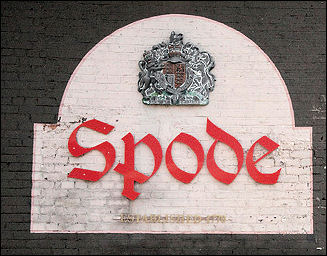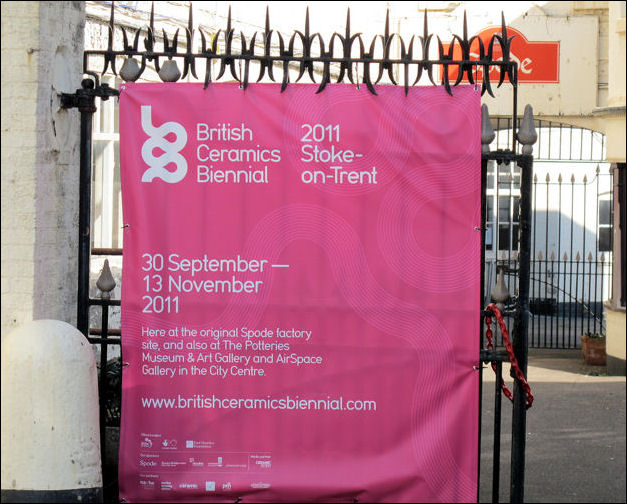|
|
|
David Proudlove's
critique of the built environment of Stoke-on-Trent
![]()
![]()
![]()
next: High Street Blues
previous: The future's
bright...
The family Silver
|
The past month or so has seen Stoke-on-Trent host the British Ceramics Biennial; a great honour for the city, and a richly deserved one given the role that the Potteries has played in the industry. The festival runs until 12 November at the former Spode Works in Stoke, where the former factory floor has been utilised to host a series of events. The
festival has received much national coverage, including a very
positive review in the Guardian, and has been a great showcase
for the ceramics industry, and the Potteries. |


the British Ceramics Biennial
at the original Spode factory
|
It has also been a great showcase for the Spode Works itself and its special atmosphere, and the interesting spaces throughout the site and its buildings. As visitors from all over the city, the country, and the rest of the world visit the site, it is a clear demonstration that the Spode Works could have a bright future, and play a positive role in the future of our city.
Or does it?
As URBED commenced work, whispers began to emanate from the Civic Centre that a new supermarket could be developed on the Spode Works site. Denials were issued. Local people showed disquiet. But when URBED’s draft plans were put to the public, there were a number of options, one of which included a new supermarket. What is the big attraction to new supermarkets here in Stoke-on-Trent and North Staffordshire? I’m guessing that the answer is that they are as cheap as chips to build and developers and supermarket chains are willing and able to dangle large cheques in front of cash-strapped local authorities in order to fund things that may be beyond their reach in the current climate. The current climate. Therefore important sites and buildings can often be sacrificed for short-term gains. We’ve seen it in Hanley where Tesco were supported and encouraged to relocate to a new, larger store because they were willing to fund the completion of the Hanley Ring Road. Short-term gain for maybe long-term pain. But does Stoke need another supermarket? Does the city need another supermarket? North Staffordshire is swamped by supermarkets. Let’s take Tesco as an example. It has numerous stores throughout the area, from Kidsgrove to Meir, and many other places in between. It is planning yet another store at the Lime Kiln crossroads just outside Hanley, around a mile from its new megastore. That is just one chain. Welcome to Tesco-on-Trent anyone?
And a supermarket on the Spode Works site? Adjacent to two Conservation Areas and a host of Listed Buildings, such as the historic core of the Spode Works site itself, and Stoke Town Hall; how is a supermarket building appropriate to such a setting? We all know that supermarkets tend to look like some sort of interplanetary craft that is set for celestial annihilation and out for universal dominance. But maybe that is appropriate; universal domination sounds like the vision set out in Tesco’s latest Business Plan…
The Spode Works site is special, and it deserves better. Much better. Stoke-on-Trent is pottery. The city has been synonymous with the industry since at least the 18th century, with recorded evidence of even earlier activity. The Spode Works has played a prominent role in the pottery industry since the mid-18th century, and the majority of the buildings still standing on the site date from the early 1800s.
The Spode Works is arguably the most important pottery site still remaining, being possibly the best example of a site that has grown organically to meet a company’s needs as opposed to have been planned in the way that Middleport Pottery was, for example. Until the firm closed its doors, Spode was the last manufacturer in the city to have still been in operation on their original site. The site and its buildings still retain a unique atmosphere, and contain some incredible spaces that could be exploited to create something spectacular.
Some of the buildings that appear in Potworks – whilst around at the time of publication back in 1991 – have long since gone. I understand the arguments of outdated facilities, and modernisation of processes, but if the people of the industry, and our local authority, cannot appreciate and respect the city’s industrial heritage and architecture, what chance the profit-hungry monsters of the development industry? This is not a new phenomenon though. The concerted destruction of the pottery industry’s built heritage gathered pace in the 1950s when the Clean Air Act rendered the industry’s unique bottle ovens obsolete, with the response being to tear them down. In the early 1970s, that renowned critic of the Potteries Sir Nikolaus Pevsner (“the Five Towns are an urban tragedy”) visited the city whilst compiling the Staffordshire edition of his tremendous Buildings of England. Pevsner was openly hostile towards the urban environment of the Potteries, and expressed particular disappointment of his trip to Wedgwood Country, Etruria:
That view today is still desolation, but a different sort of desolation: sheds and off-the-peg office buildings delivered by St Modwen; the desolation of a failing and out-dated regeneration model.
That was around forty years ago; but even now in 2011, the city still has less than 200 Listed Buildings. Despite the importance of the Spode Works, it only received some protection back in 2007 when the Church Street Conservation Area was extended to include the site’s historic core, and four of the buildings were Listed at Grade II (I understand that the Housing Market Renewal Pathfinder RENEW North Staffordshire opposed this; what a great surprise that is).
Too much of the Potteries’ industrial heritage continues to disappear at an alarming rate. In recent years we have lost the Alexandra Pottery in Tunstall – indeed hardly anything of the pottery industry remains in Tunstall – and the former Royal Doulton site on Nile Street in Burslem now resembles a scene from the Blitz. Even those that are Listed are under threat: the Falcon Pottery on Old Town Road in Hanley is fast falling down around our ears; the wonderful Boundary Works in Longton is fast deteriorating; and the Hill Works in Burslem – recently vacated by Wades and now owned by St Modwen, who also own the Nile Street site – was victim of a ‘mysterious’ fire last year. And there are many more, large and small.
It is thought that the City Council are considering selling off the whole of the site, and will not retain any interest at all. We cannot continue to allow the wholesale selling off of the family silver. The Potteries Family Silver.
So what are the alternatives?
Would you expect to see an Asda superstore appear alongside the Albert Dock? Would you hear debate over the positives of Sainsbury’s locating a store alongside the Bridgewater Canal in Castlefield? I think we know the answer.
The common theme that runs through projects such as Trinity Buoy Wharf and Coin Street, is that the ‘traditional’ regeneration and development model was shunned in favour of a more organic and community-focused approach. It is clear that in the current economic climate, the usual model is broken. It will not work, and it will not work at the Spode Works. Public sector spending has all but disappeared. There is a real lack of private sector development finance available, and lenders have become far more risk averse, and a proposition such as the Spode Works – a former industrial site that includes a host of Listed Buildings, and part of which sits within a Conservation Area, would be far too risky from the perspective of banks and other financial institutions. This may paint a very bleak picture. But for these reasons, the Spode Works is the biggest opportunity in the city right now. It presents the opportunity for the city to turn its back on the wrecking ball and rubble approach. It is THE opportunity for the city to pioneer a different model to drive regeneration; a community-led approach that forsakes short-termism in favour of a longer-term view, an approach that will allow people and businesses to lay down roots and grow organically, in much the same way that the Spode Works itself has.
The future of the Spode Works could be the catalyst for the city to start thinking seriously about, and acting positively and proactively towards developing a sustainable future for ceramics, design, and associated industries in the city, taking the industries for which Stoke-on-Trent is famous into the 21st century. I would call on the City Council to be brave; to show courage, to show some vision in respect of Spode Works and the role it can play in our city’s future. To place a vote of confidence in the site, in Stoke, in the city, and more importantly in the creative people and industries of the Potteries, and ensure that the Spode Works remains at the heart of ceramics and design in Stoke-on-Trent, and thus, on the world stage. David
Proudlove |
next: High Street Blues
previous: The future's bright...
|
Related pages.. Neville Malkin's tour of Spode Works external links.. |